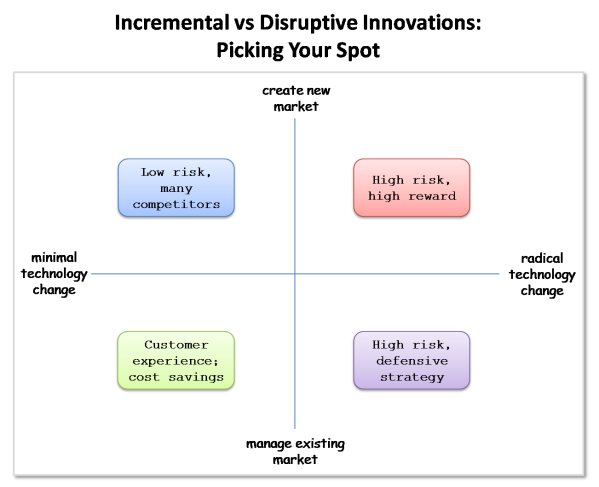Solving For Impossible: The Four Quadrants of Innovation
![]() I recently wrote up a post, Most Dangerous Innovation Misperception – The Silver Bullet Approach. In it, I discussed the issue of organizations myopically focusing on only disruptive innovations to the exclusion of more incremental or sustaining innovations.
I recently wrote up a post, Most Dangerous Innovation Misperception – The Silver Bullet Approach. In it, I discussed the issue of organizations myopically focusing on only disruptive innovations to the exclusion of more incremental or sustaining innovations.
In doing more research on the subject, I began thinking about the dynamics that apply when a firm pursues different kinds of innovation. A post by Venkatesh Rao, Disruptive versus Radical Innovations, was very useful for distinguishing between disruptive and radical innovations.
Building on that, I wanted a framework for delineating innovations based on their technology and business impacts. Because they’re not necessarily the same. The four quadrants below describe the dynamics for innovations according to their technology and market impacts:
 In each quadrant, there are different rationales and issues that apply. Let’s take a look.
In each quadrant, there are different rationales and issues that apply. Let’s take a look.
Existing Tech, Manage Existing Market
The lower left quadrant represent innovations that leverage existing technology, and service existing customers. This is every day innovation. The block-n-tackle innovation that keeps companies nimble and operating at rates above industry averages.
Example? See how Walmart improved the fuel efficiency of its vehicle fleet:
Wal-Mart has taken a number of steps, including the installation of diesel Auxiliary PowerUnits on all its trucks, and applying aerodynamic skirting. On the tire side, Wal-Mart is working with super single tires. and is testing nitrogen-filled tires and an automatic filling process to maintain constant tire air pressure.
Improving the customer experience is also a critical opportunity. In an era of social-media empowered customers impacting your brand, the consequences of failing to improve the customer experience are higher than ever.
![]() But this quadrant is the one often pooh-poohed by many in innovation. I like the way PriceWaterhouseCoopers puts it in this blog post:
But this quadrant is the one often pooh-poohed by many in innovation. I like the way PriceWaterhouseCoopers puts it in this blog post:
An unintended consequence of the Innovators Dilemma has been that companies have begun believing that unless they were pursuing a strategy of seeking disruptive innovations, they were somehow losing out.
Walmart’s efforts have paid off. The retailer has held relatively strong during the Great Recession, as seen in its stock price. And Toyota famously gathered over million ideas a yearfrom its employees to emerge as a global leader in the automotive industry.
Existing Tech, Create New Market
In this quadrant, existing technology is leveraged to create a new revenue streams. This is the quadrant where the following phrase applies:
Good artists borrow. Great artists steal.
The simple application of a technology that serves one purpose toward a different purpose can be disruptive from a market perspective. It’s not a large technological leap. It’s the intelligent application of what’s already at hand.
![]() Twitter is a great example. The technology itself is…simple. Web form. Subscription model. Limit to 140 characters. Yet it’s revolutionized the way people share and find information, causing Techcrunch’s MG Siegler to compare it to a modern day Walter Cronkite. All for a simple little web app. Here’s what WordPress founder Matt Mullenweg says about Twitter:
Twitter is a great example. The technology itself is…simple. Web form. Subscription model. Limit to 140 characters. Yet it’s revolutionized the way people share and find information, causing Techcrunch’s MG Siegler to compare it to a modern day Walter Cronkite. All for a simple little web app. Here’s what WordPress founder Matt Mullenweg says about Twitter:
Whether the Twitter team intended it or not, they’ve built a killer and highly addictive reader platform with dozens of interesting UIs on top of it.
The thing with these innovations is that they are very much a market-determined disruption. This isn’t some sort of EUREKA! the moment the technology is rolled out of the labs. It takes the market to say that it’s disruptive.
Clayton Christensen (Innovator’s Dilemma) types of innovation will often fall in this quadrant. Existing technologies applied in new ways to address the lower end of the market.
Venkatesh Rao has a great perspective on this quadrant:
In fact, in most documented cases of disruption, the disruptive innovation was a minor/incremental change and well within the technical capabilities of the incumbent (and was often taken to market by a renegade spin off from the original company).
This quadrant is the best one for producing organic growth for companies. It has lower risk, but produces meaningful revenue growth.
Radical Tech, Create New Market
If any one quadrant defines the popular view of innovation, it’s this one. And that’s not without good reason. In the previous quadrant, existing technologies are applied to new markets. Well, existing technologies have to come from somewhere. That’s this quadrant.
![]() This is the cool stuff that the press writes about. Check out AT&T’s Technology Showcase for a great example of some of these new technologies.
This is the cool stuff that the press writes about. Check out AT&T’s Technology Showcase for a great example of some of these new technologies.
Amazon’s Jeff Bezos has done well in this quadrant. His latest innovation, the Kindle, is an example. It includes a new “electronic ink“. Ability to read text aloud. It’s incredibly thin profile.
And it’s paying off. Amazon reports that the Kindle set a new sales record this November. Which points to the Kindle as a strong new revenue stream down the road, and a new source of sales for Amazon’s book sales. A home run in this quadrant.
These types of innovations are important for maintaining the long-term growth rates of companies. They provide needed growth, replenishing changes in existing markets.
Which leads us to the final quadrant…
Radical Tech, Manage Existing Market
There are times a company’s business is under attack, and it needs to address changing behaviors in its market. Innovations in this quadrant share the high risk profile of the previous quadrant, but they have a defensive nature to them. They don’t seek to find new opportunities, they seek to address changes in customer behavior.
Hulu strikes me as an example of this. A joint venture of NBC, Fox and ABC, Hulu lets users view shows on computers. This initiative addresses the emerging market shift away from televisions to viewing on all sorts of devices. It’s a better answer for this shift than the music industry initially had for the proliferation of MP3 songs on various P2P sites.
Gary Hamel has noted the increasing volatility of markets across the globe. Customers have better access to information about new options, and are willing to shift their spending more quickly. With this dynamic, expect some increase in activity for innovations in this quadrant.
Companies Need a Portfolio of Innovation Opportunities
![]() In a recent Accenture survey, 58% of executives said their organization is looking for the next silver bullet rather than pursuing a portfolio of opportunities. When I hear that, I think first of the upper right quadrant (radical tech, create new market). These types of innovations are incredibly important, and should be part of a company’s innovation efforts.
In a recent Accenture survey, 58% of executives said their organization is looking for the next silver bullet rather than pursuing a portfolio of opportunities. When I hear that, I think first of the upper right quadrant (radical tech, create new market). These types of innovations are incredibly important, and should be part of a company’s innovation efforts.
But there’s really a good basis for expanding that view to look at the other types of innovation: technology vs. market, disruptive vs incremental.
A message from John Furrier, co-founder of SiliconANGLE:
Your vote of support is important to us and it helps us keep the content FREE.
One click below supports our mission to provide free, deep, and relevant content.
Join our community on YouTube
Join the community that includes more than 15,000 #CubeAlumni experts, including Amazon.com CEO Andy Jassy, Dell Technologies founder and CEO Michael Dell, Intel CEO Pat Gelsinger, and many more luminaries and experts.
THANK YOU













